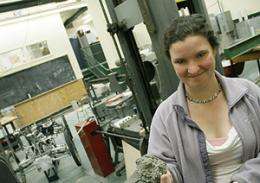Breaking Up Can Be Hard

Laura Townsend '10 eases a soggy lump of concrete out from what looks like a gigantic pizza oven. "Come on, whoa! -- This bad boy is going to fall apart," she says as she inspects the pebbly mass and then gingerly places it back in a tray of water. A few weeks ago, this concrete was solid. Now it's been through about six years of ferocious weathering.
"This is a freeze/thaw chamber," she says, "Twenty cycles in here is like a year in Burlington." Cooked and frozen every five hours for days, her samples get old in a hurry.
"My honors thesis is evaluating the effects of weathering on fluid transport through building materials -- like how much more fluid can get into concrete as it gets older," she says. And if that fluid happens to be a chemical weapon, the Defense Threat Reduction Agency would like to know what happens to it.
Townsend's research is part of a project led by her co-advisers -- professors Mandar Dewoolkar and Donna Rizzo in the College of Engineering and Mathematical Sciences -- and supported by the defense agency.
"Our goal is to understand the pore structure of common building materials," Dewoolkar says, "with the eventual goal of developing decontamination strategies in case of attack."
"Each material is going to be different," says Dewoolkar, " If you take a block of concrete that is fresh, it's going to behave differently than if it has been sitting out for 10 years: there are going to be microcracks and other changes. How porous these materials are will affect the depth of contamination and how you clean it up."
Hit by a terrorist's weapon or a more mundane chemical spill, weathered concrete might become deeply saturated, requiring complex treatments -- while "one of the sandstones I'm using has such low permeability you could probably just wipe it off," says Townsend.
Costly caustics
But not all buildings would be worthy of the high price tag on decontamination. "Our job is to model fluids," says Rizzo, "but Laura took it one step further -- she realized that the buildings people would be most concerned with tend to be historical. So now Mandar and I are keyed in on the historical preservation side of this work."
On Dewoolkar's list of examples: the White House, Library of Congress, museums -- as well as hospitals, military bases, bridges and runways. "There has to be a way decontaminate these quickly," he says, "since demolition would not be an option."
As for Townsend -- an environmental engineering major and member of UVM's Honors College -- she's spent the better part of a year gathering first-of-its kind data on the hydraulic conductivity and gas permeability of sandstone, limestone, landscaping brick and four forms of concrete.
"I didn't really know what to expect when I started because no one has done anything like this before," she says, holding up a cut cylinder labeled Arkose Sandstone. The stone still feels hot from coming out of the kiln where it was drying all night. "I need to make sure there is no water in the pores if I'm going to get an accurate measure of air permeability," she says.
Next, her samples are re-saturated to measure hydraulic conductivity -- and then, finally, back in the kiln again before being tested for surface permeability in "this crazy machine," says Townsend, patting a table-sized device that looks like a cross between a drill press, a surgical bed and R2D2.
"This machine costs more than going to college," Townsends says, almost to herself. Then she composes herself. "It's the Autoscan II. It measures gas permeability at the surface. See, this nozzle drops down and it has a tip that presses against the sample. The pressure makes a seal with the surface and forces air through to measure flow."
In her dust
"When I'm working, I'm not really thinking, 'Oh gosh, chemical weapons, terrorist attacks!'" Townsend says. "I'm asking: 'How much fluid gets in?" And people in the construction industries may find the answer to that question very useful. "If you have a basement and there is a flood going on," Townsend says, "this research can help you figure out how much water is getting into your cellar."
"This research is pertinent to a lot more than chemical weapons," she says. And Townsend's part of the research effort has largely been propelled by her own grants and awards including a Barrett Foundation scholarship4 and a URECA award5.
"Wherever I walk now I trail concrete dust," Townsend says, laughing, "But it feels great after I present my work," -- as she was invited to do at the American Geophysical Union's national meeting last December -- "to have a professor or someone in industry say, 'You're an undergrad? This is really good!' Research has emotional benefits."
Provided by University of Vermont


















